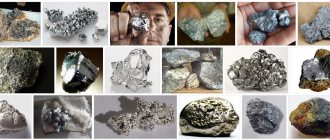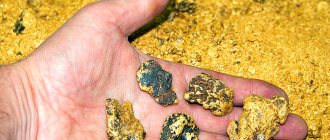Hello, dear readers of the Tyulyagin project! Today we will talk to you about gold. This is already the third article about it, if I don’t confuse anything, then we have already talked about the gold reserves, and touched on gold in the article about the gold and foreign exchange reserves of the countries of the world, today we’ll talk about gold mining in countries around the world. In addition, in the article you will find out what gold is used for in the modern economy, you will find out the largest exporters and importers this precious metal, as well as leading countries in gold consumption. In addition, the article contains unique statistics on gold mining in Russia (in the Russian Empire and the USSR) since 1600.
What is gold and what is it used for?
Gold is a noble metal of yellow color. This metal is very highly valued by people and is one of the most expensive among other metals. The high cost of the metal is largely due to its rarity in nature. Although the metal is actually not that rare, since it is found in small quantities almost everywhere. So gold can be found in the earth's crust, it is contained in sea and river water. However, the gold mining process itself is extremely labor-intensive and requires a large amount of work. To get just one ounce of gold, you need to process about 3 tons of ore.
Gold reserves on Earth are insignificant relative to other metals. Gold has good preservation properties. Throughout world history, gold has rarely been lost and has always been melted down and accumulated again. All this allowed gold to become an important element of the economy and financial system of many countries. Nowadays, gold is used as an important way of investing and accumulating capital. Often, investors invest their savings in this asset during periods of economic instability. Gold is also actively used by countries around the world in the formation of the country's gold reserves and gold and foreign exchange reserves. However, gold has a number of other applications in economics, investment and trade - jewelry, medicine, modern industry and others.
Gold is the most popular metal in the manufacture of jewelry metals. However, gold itself is a very soft metal, and when making jewelry, other metals are added in addition to gold to make it harder. Most often, zinc, copper, silver, platinum, palladium and other non-ferrous metals are added when making jewelry.
Due to its metallic properties (malleability, ductility, resistance to aggressive environments), gold is actively used in modern industry in the manufacture of ultra-thin products, for example, in the manufacture of modern electronics - processors, various circuit boards, etc. In addition, gold is used in aviation, nanotechnology, chemical industry and other industries. Gold is even used in nuclear energy.
Due to its low oxidation, gold has found extensive use in dentistry. The precious metal is also used in some medicines for the treatment of tuberculosis, arthritis and cancer.
Obtaining gold using the etching method
Few people might have thought about it, some might simply not know, but almost every person on the planet carries a small piece of yellow metal with them every day. Any telephone SIM card contains a certain amount of gold. Some countries of the world and Europe that mine gold even extract it from such items in the process of recycling waste.
Electrolysis technology.
This can only be done in two ways:
- Electrolysis;
- By etching.
To use the second method, you need to use nitric acid, which is popularly known as aqua regia. Etching is the most common and popular method. It is convenient due to its simplicity, as well as the natural property of gold to interact with many other metals and elements.
Leading countries in gold reserves
I already wrote about gold reserves in countries around the world in one of my articles. Therefore, now I will only briefly list a short list of the world leaders in gold reserves. In a separate article you can see the complete list of countries in the world by gold reserves at the end of 2019 - beginning of 2022.
the United States leads the overall ranking ; the gold reserves of the states today exceed 8.1 thousand tons . The closest pursuer, Germany, lags behind by more than two times in terms of gold reserves. In Germany, the gold reserve is 3.3 thousand tons. The top 5 countries in the world also include Italy (2.45 thousand tons), France (2.43 thousand tons) and Russia (2.2 thousand tons). In addition, the top ten also included China, Switzerland, Japan, India and the Netherlands. More detailed statistics on gold reserves here.
Canada - 110 tons
Ah, Canada, land of snow, oil and precious metals. Most of Canada's gold comes from Ontario, specifically the Red Lake mine. Canada is so patriotic about its own gold that you can purchase a Canadian gold coin for just a few hundred dollars. However, you need to hurry because the country's gold mines are among the smallest among the countries on this list.
Rating of countries in the world by gold production
People have been mining gold for a very long time. The first mentions of gold begin 5 thousand years BC. It is believed that the first region where humanity began to mine gold was the Middle East. In addition, gold was also mined in Ancient Egypt. Over the next centuries, gold repeatedly became the target of wars.
The discovery of new large gold deposits has always led to significant changes in the economies of regions and entire states. The discovery of particularly large deposits led to a gold rush.
Gold is valued by many countries to this day. Many states are trying to accumulate and extract as much gold as possible in order to ensure a stable future for their state and economy.
So, at the end of 2022 (statistics for 2022 as of May 2022 are unknown), the leaders in gold production are China, Australia, Russia and the USA .
China ranks first and produces about 400 tons of gold per year . It’s interesting, but less than 50 years ago, production in China did not exceed 10 tons per year; in those years, South Africa was the undisputed leader in gold production, with production of 700-1000 tons of gold annually. However, since 1980, production in China began to grow rapidly. So, by 1990, China had produced a record 100 tons of gold for the country at that time, by 2005 it had already produced more than 200 tons, and throughout the last decade it has been consistently producing more than 300 tons of gold every year.
Australia's production is about 310-315 tons of gold , it ranks second. Gold mining in Australia also began to develop rapidly in the 80s of the last century. In just ten years from 1980 to 1990, production increased 10 times and amounted to about 240 tons. Mining continued to grow until 1997, when more than 300 tons of the precious metal were mined. Since then, gold production in Australia has fluctuated at 250-320 tons of gold per year.
Russia is in third place with production of about 282-300 tons of gold, according to various estimates. However, according to preliminary forecasts, gold production in Russia at the end of 2022 amounted to about 350 tons. This figure will allow Russia to move into second place after China at the end of 2019. We'll talk more about gold mining in Russia below in the corresponding paragraph.
Following the top three is the USA with production of 220-250 tons of gold per year . The current production level is not a record for the United States. Gold production in the United States peaked at the end of the last century, when more than 350 tons were mined annually.
You can see the complete list of countries in the world by gold production
| A country | Tons (World Gold Council) | Tons (GFMS, Thomson Reuters) |
| China | 404.1 | 399.7 |
| Australia | 314.9 | 312.2 |
| Russia | 297.3 | 281.5 |
| USA | 221.7 | 253.2 |
| Canada | 189 | 193 |
| Peru | 158.4 | 155.4 |
| Indonesia | 136.9 | 190 |
| Ghana | 130.5 | 101.8 |
| South Africa | 129.8 | 123.5 |
| Mexico | 115.4 | 121.6 |
| Brazil | 97.1 | 82.2 |
| Uzbekistan | 92.5 | 83.4 |
| Sudan | 76.6 | |
| Papua New Guinea | 69.1 | 70.9 |
| Kazakhstan | 68.4 | 69.8 |
| Mali | 61.2 | 57.8 |
| Argentina | 60 | 63.3 |
| Burkina Faso | 59.3 | 55 |
| Tanzania | 47.7 | |
| DR Congo | 44.9 | 64.8 |
| Colombia | 43 | 51.2 |
| Zimbabwe | 42.2 | |
| Ivory Coast | 40.9 | |
| Philippines | 36.8 | 46.6 |
| Chile | 36.5 | |
| Suriname | 34.3 | |
| Dominican Republic | 31.6 | |
| Guinea | 27.3 | |
| Guyana | 25.6 | |
| Türkiye | 24.9 | |
| Bolivia | 24.1 | |
| Venezuela | 23 | |
| Mongolia | 22.6 | |
| Kyrgyzstan | 22.1 | |
| Senegal | 17.5 | |
| Egypt | 14.7 | |
| Nigeria | 14 | |
| Ecuador | 11.5 | |
| Iran | 11 | |
| Ethiopia | 11 | |
| New Zealand | 9.3 | |
| Finland | 8.3 | |
| Sweden | 7.9 | |
| Bulgaria | 6.8 | |
| Other countries | 555.5 | |
| The whole world | 3321.7 | 3332.2 |
Import and export of gold by country of the world
The largest importers of gold, according to statistics from the International Trade Center for 2022, are:
- UK ($70.7 billion)
- Switzerland ($60.6 billion)
- China ($43.9 billion)
- India ($32.1 billion)
- Hong Kong ($13.9 billion)
- Türkiye ($11.2 billion)
- Singapore ($10 billion)
- USA ($9.6 billion)
- Thailand ($7 billion)
- UAE ($6.7 billion)
In total, in dollar terms, more than $306 billion worth of gold was imported in 2022. As for Russia , it is not among the top 50 countries for imports. Its gold imports in 2022 were only $15.8 million .
The largest exporters of gold in 2022, according to ICT statistics, are:
- Switzerland ($61.9 billion)
- Hong Kong ($25.1 billion)
- UK ($23.3 billion)
- UAE ($17.7 billion)
- USA ($17.1 billion)
- Australia ($16.2 billion)
- Canada ($15.3 billion)
- Singapore ($11.5 billion)
- Thailand ($7.5 billion)
- Peru ($6.7 billion)
Russia is in 13th place ; gold exports in 2022 amounted to $5.7 billion , although in previous years it was significantly less.
Countries leading gold consumption in the world
Speaking about gold consumption, we are primarily talking about the use of gold in the jewelry industry (70-80% of total consumption), as well as its use in electronics, medicine and other industries. Thus, the leaders in consumption at the end of 2022 were:
- China - 785.2 t
- India - 700.5 t
- USA - 156 t
- Japan - 99.9 t
- Türkiye - 98.4 t
- Italy - 83.6 t
- South Korea - 80.9 t
- South Africa - 70.7 t
- Iran - 62.8 t
- Indonesia - 49.1 t
In total, 2816.5 tons of gold were used in the world in 2022. Moreover, the most active demand for gold consumption comes from the countries of the Asian region. Russia's consumption at the end of 2022 amounted to 47.4 tons , it took 11th place right after Indonesia.
You can see the full statistics of gold consumption by country in the table below under the spoiler:
Expand the table of gold consumption in countries around the world
| A country | Gold consumption, t |
| The whole world | 2816.5 |
| China | 785.2 |
| India | 700.5 |
| USA | 156 |
| Japan | 99.9 |
| Türkiye | 98.4 |
| Italy | 83.6 |
| South Korea | 80.9 |
| South Africa | 70.7 |
| Iran | 62.8 |
| Indonesia | 49.1 |
| Russia | 47.4 |
| Germany | 43.7 |
| UAE | 42.7 |
| Switzerland | 35.7 |
| Saudi Arabia | 34.4 |
| Malaysia | 30.1 |
| Singapore | 28.2 |
| Canada | 25 |
| Thailand | 24.7 |
| Egypt | 24.5 |
| Taiwan | 23.9 |
| Brazil | 23.8 |
| Great Britain | 21.4 |
| Vietnam | 20 |
| Pakistan | 17.9 |
| Australia | 12.7 |
| Austria | 12.5 |
| Kuwait | 11.8 |
| Jordan | 11.4 |
| Sri Lanka | 9.8 |
| Mexico | 9.6 |
| Uzbekistan | 8.3 |
| Lebanon | 8.1 |
| France | 6.8 |
| Morocco | 6.3 |
| Kazakhstan | 6 |
| Bahrain | 5.6 |
| Spain | 5.3 |
| Israel | 5.1 |
| Greece | 3.9 |
| Iraq | 3.6 |
| Oman | 3.2 |
| Myanmar | 3 |
| Poland | 2.8 |
| Libya | 2.8 |
| Nepal | 2.6 |
| Chile | 2.5 |
| Philippines | 2.4 |
| Netherlands | 2.2 |
| Costa Rica | 1.8 |
| Hong Kong | 1.8 |
| Qatar | 1.8 |
| Portugal | 1.5 |
| Bangladesh | 1.5 |
| Czech | 1.1 |
| Belgium | 0.8 |
| Luxembourg | 0.2 |
| Finland | 0.1 |
Dynamics of gold mining in Russia since 1600
While writing this paragraph, I looked through quite a few different sources of information with statistics on gold production in Russia. It took more than 1 day to find excerpts of statistics from various official and unofficial sources. Statistics from the State Statistics Committee, the IMF, the Union of Gold Miners of the Russian Federation and others were used as official statistics. Unofficial sources include various studies and excerpts from the literature of experts in the field of the gold industry and economics.
It’s worth saying right away that for most of the time period since 1600, it was possible to unearth only approximate statistics on gold production. The greatest difficulty arose with finding information about gold mining in the USSR from 1921 to 1991, since this information is classified. However, some data was still found due to the fact that some of the information was declassified by the US CIA.
The dynamics of gold mining in Russia and the Russian Empire from 1600 to 1900 were only averaged, but they are extremely valuable:
- 1600 - 1740 - about 17.7 tons of gold were mined over 140 years
- 1740-1760 - average annual production was 40 kg of gold
- 1761-1780 - average annual production was 95 kg of gold
- 1781-1800 - average annual production was 130 kg of gold
- 1801-1810 - average annual production was 165 kg of gold
- 1811-1820 - average annual production was 315 kg of gold
- 1821-1830 - average annual production was 3375 kg of gold
- 1831-1840 - average annual production was 7050 kg of gold
- 1841-1850 - average annual production was 22.52 tons of gold
- 1851-1860 - average annual production was 25.65 tons of gold
- 1861-1870 - average annual production was 27.07 tons of gold
- 1871-1880 - average annual production was 37.97 tons of gold
- 1881-1890 - average annual production was 35.74 tons of gold
- 1891-1890 - average annual production was 40.13 tons of gold
It was possible to find statistics on gold production since 1900 in more detail by year, but some years are still missing. If you have more detailed information on the missing years, write it in the comments. You can view gold production statistics in Russia since 1900 in the graph below:
Data on gold production in Russia in recent years may vary slightly, depending on the source. So, according to data from the Union of Gold Miners, gold mining in Russia over the past few years is as follows:
- 2013 - 254.8 t
- 2014 — 288.5 t
- 2015 — 293.8 t
- 2016 — 297.4 t
- 2017 — 318.1 t
- 2018 — 329.9 t
In other words, according to these statistics, Russia for the first time began to produce more gold than during the Soviet era.
And that’s all for today about gold mining in Russia and countries around the world. Add the article to bookmarks and share with friends. Subscribe to new articles by e-mail, good luck and see you again on the pages of the Tyulyagin !
- 25
Shared
Russia – 200 tons
It is not surprising that Russia got a lot of gold, since it occupies approximately one-sixth of the entire world's territory. More than five thousand tons are still in reserve, much of it has not yet even begun to be mined, particularly in eastern Siberia, but Russia has already begun importing gold to quench its thirst for the shiny metal. For example, in 2012, the country imported approximately five percent of gold to replenish its bank reserve, which stands at about 900 tons. Whether the metal is in a jar or underground, Russia definitely loves gold.
Using a radio telescope, astronomers looked at the “cosmic jellyfish” for the first time
NASA discovered a snake-like exoplanet with its own atmosphere
What does Sergei Yursky's daughter do: she looks very much like him (new photos)










